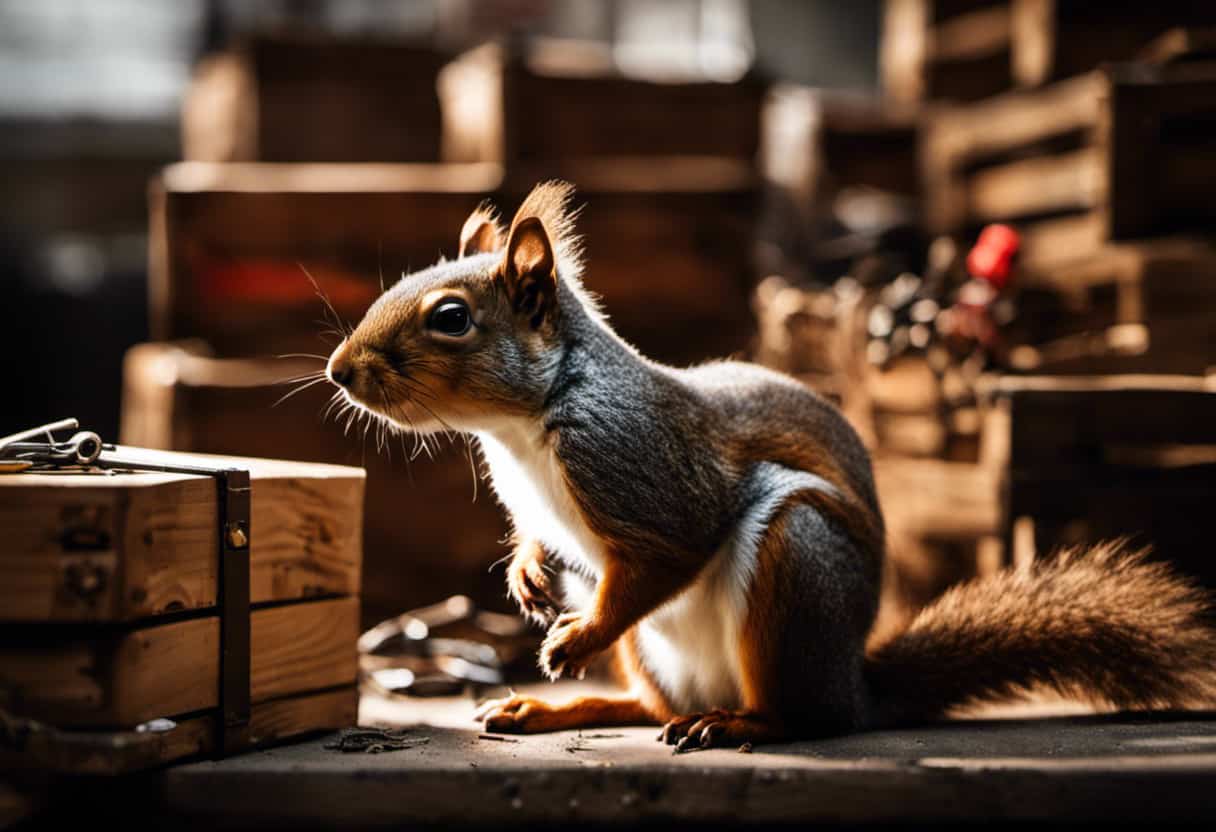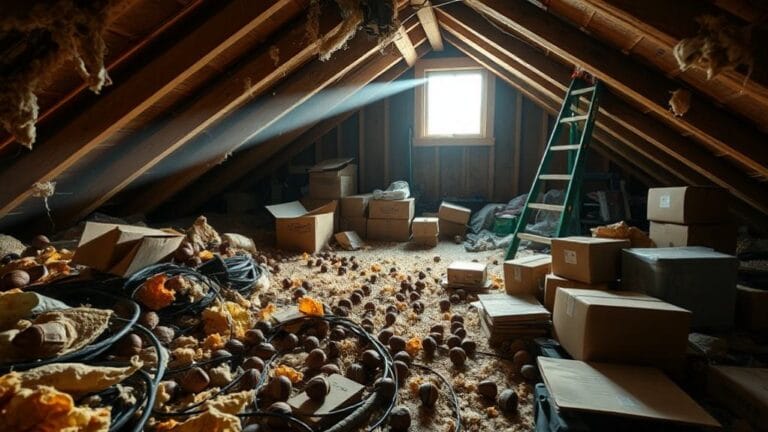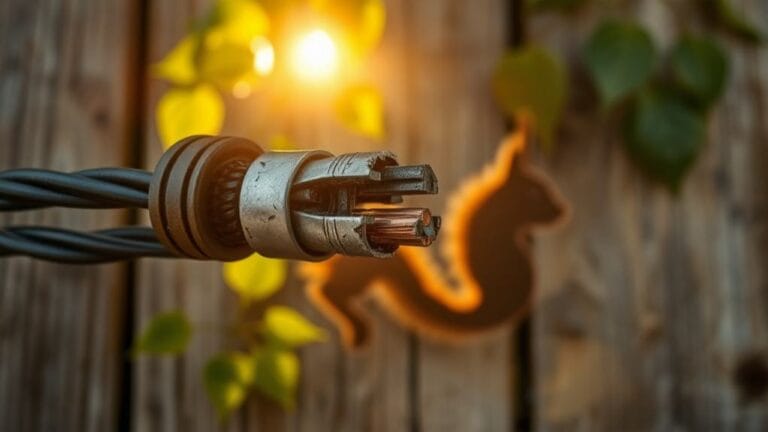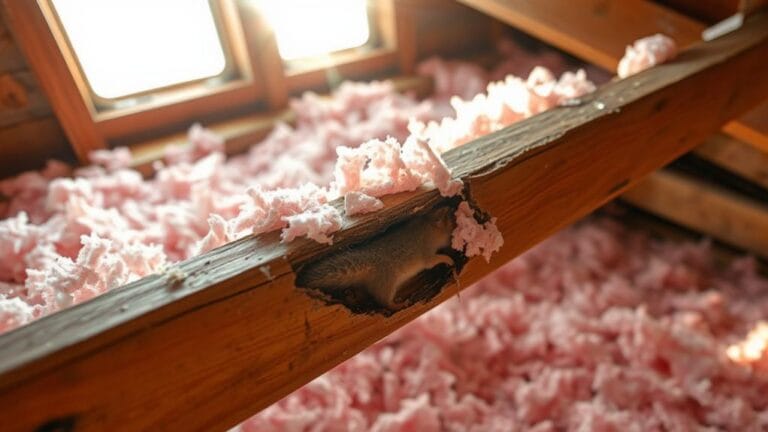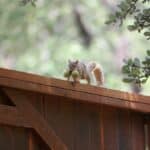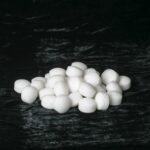Are pesky red squirrels taking over your garage? Don’t fret, we’ve got you covered!
In this article, we’ll show you how to reclaim your space and get rid of those furry intruders.
You’ll learn how to identify their presence, understand their behavior, and assess the potential damage they can cause.
We’ll also provide you with practical tips on preventing their entry, removing food sources, and using natural deterrents.
Say goodbye to red squirrels and hello to a squirrel-free garage!
Key Takeaways
Table of Contents
- Signs of red squirrel presence in the garage include chewed wires and nesting materials.
- Red squirrels have diverse diets and foraging behaviors, making it important to remove food sources that attract them to the garage.
- Preventing red squirrels from entering the garage involves sealing potential entry points, using caulk, weatherstripping, or steel wool, and installing mesh or wire screen over vents.
- To remove red squirrels from the garage, live traps and DIY repellents can be used, entry points should be sealed to prevent their return, and trapped squirrels should be released far away from the property.
Identifying the Presence of Red Squirrels in Your Garage
You’ll want to look for signs like chewed wires and nesting materials to determine if red squirrels are in your garage. Red squirrels are known for their destructive behavior, so it’s important to act quickly if you suspect their presence.
Inspect the area thoroughly, paying close attention to any gnawed or frayed wires, as this can indicate their activity. Additionally, keep an eye out for nesting materials such as leaves, twigs, and shredded paper.
If you notice these signs, it’s recommended to call a professional pest control service. They have the expertise and tools to safely remove the squirrels from your garage without causing harm to you or the animals.
Understanding the Behavior and Habits of Red Squirrels
If you want to understand the behavior and habits of red squirrels, it’s important to look at their nesting habits, food preferences, and foraging, as well as their daily activity patterns.
Red squirrels are known to build their nests in tree cavities or leaf nests called dreys, which they construct using leaves, twigs, and moss.
They have a varied diet consisting of nuts, seeds, fruits, and even bird eggs, and they are skilled foragers, burying their food for future consumption.
In terms of daily activity patterns, red squirrels are diurnal creatures, meaning they are most active during the day, with peak activity occurring in the morning and late afternoon.
Squirrel Nesting Habits
To prevent red squirrels from nesting in your garage, make sure to seal off any potential entry points. Red squirrels are resourceful creatures that can find their way into small openings, so it’s important to thoroughly inspect your garage for any gaps or holes.
These pesky critters are also known for using various materials to build their nests, such as leaves, twigs, and moss. They will typically seek out cozy and secluded areas to build their nests, such as in attic spaces, wall voids, or even inside stored items.
Therefore, it’s crucial to declutter your garage and store items in sealed containers to eliminate potential nesting spots. By taking these preventative measures, you can effectively deter red squirrels from making your garage their home.
Food Preferences and Foraging
When it comes to their food preferences and foraging habits, red squirrels are known to have a wide variety of tastes. These small, agile creatures have adapted to survive in various environments, allowing them to find food sources in both urban and rural areas.
Here are some key points about their diet and foraging habits:
Red squirrels have a diverse diet that includes nuts, seeds, berries, fruits, and even mushrooms. They are opportunistic eaters and will also consume insects, eggs, and small birds if given the chance.
They have excellent memory and are known to stash food in multiple locations, creating hidden caches to sustain them during periods of scarcity. This behavior helps them survive during winter when food availability is limited.
Red squirrels are active foragers, spending a significant amount of time searching for food. They are adept climbers and can easily navigate trees to reach their preferred food sources.
Understanding the red squirrel diet and foraging habits can help us better manage their presence and reduce any conflicts between humans and these furry creatures.
Daily Activity Patterns
During the day, red squirrels are most active, scurrying around trees and searching for food. These daily activity patterns are essential for their survival and reproduction.
Red squirrels have developed various behavioral adaptations to thrive in their environment. They are diurnal creatures, meaning they are active during the day and rest at night. This allows them to take advantage of the daylight to find food and engage in social interactions.
Red squirrels are highly agile and nimble, allowing them to navigate through tree branches with ease. They have a keen sense of smell, which helps them locate hidden food caches. They also have sharp claws and strong jaws, enabling them to crack open nuts and seeds.
Assessing the Potential Damage Caused by Red Squirrels in Your Garage
You should take a look at the potential damage caused by red squirrels in your garage. These critters may seem harmless, but they can wreak havoc on your property if left unchecked.
Here are some steps for effectively assessing the damage and removing red squirrels from your garage:
Inspect the garage: Look for signs of squirrel activity such as chewed wires, gnawed wood, or nests made of twigs and leaves.
Assess the extent of the damage: Determine the areas that have been affected and evaluate the severity of the damage.
Identify entry points: Find the openings through which squirrels are gaining access to your garage and seal them off to prevent further intrusions.
Preventing Red Squirrels From Entering Your Garage
To prevent red squirrels from entering your garage, it’s important to identify and seal off any potential entry points. These pesky creatures can cause significant damage to your belongings, chew on wires, and create a mess with their droppings.
Start by inspecting the exterior of your garage for any gaps or openings that squirrels can squeeze through. Check for holes in the walls, gaps around windows or doors, and gaps where pipes or cables enter the garage. Seal these openings using materials like caulk, weatherstripping, or steel wool.
Additionally, consider installing a metal mesh or wire screen over vents and openings to prevent squirrels from getting inside. Keeping your garage clean and free of food sources will also deter squirrels from making it their new home.
Removing Food Sources That Attract Red Squirrels to Your Garage
By removing food sources, it’s easier to deter those pesky red squirrels from entering your garage. Here are some tips to help you eliminate food sources and prevent red squirrels from being attracted to your garage:
Identifying red squirrel nesting sites:
Look for nests in trees near your garage.
Pay attention to areas with high squirrel activity, such as branches or trees with chewed bark.
Keep an eye out for leafy nests made of twigs, leaves, and other materials.
Understanding red squirrel territorial behavior:
Red squirrels are territorial and will defend their nests aggressively.
They mark their territory with scent glands, so be cautious of areas with a strong musky smell.
Keep in mind that red squirrels are agile climbers and can access your garage through tree branches or nearby wires.
Using Natural Deterrents to Repel Red Squirrels From Your Garage
Consider using natural deterrents such as peppermint oil or vinegar to repel those pesky red squirrels from your garage.
These natural methods can effectively deter squirrels without causing harm to the animals.
Peppermint oil has a strong scent that repels squirrels, so you can soak cotton balls in the oil and place them in areas where squirrels frequent.
Vinegar, on the other hand, has a strong odor that squirrels dislike, so you can mix equal parts of vinegar and water and spray it around your garage.
Additionally, you can use motion-activated sprinklers to startle squirrels and discourage them from entering your garage.
Remember to seal any entry points to prevent squirrels from finding their way back in.
With these natural deterrents, you can achieve humane squirrel control and protect your garage from their pesky presence.
Implementing Trapping Methods to Capture Red Squirrels in Your Garage
If you’re dealing with a red squirrel infestation in your garage, it’s time to implement effective trapping techniques to capture these critters. Understanding red squirrel behavior is key to devising a successful trapping strategy.
By analyzing their patterns and preferences, you can strategically place traps to increase your chances of capturing them.
Once you have successfully trapped the red squirrels, it’s crucial to take preventive measures to avoid future infestations. By sealing any entry points and implementing deterrents, you can create a squirrel-free environment in your garage.
Effective Trapping Techniques
To effectively trap red squirrels in your garage, you’ll need to use the right techniques. These techniques will not only help you remove the squirrels from your garage but also prevent them from coming back.
Here are some effective trapping techniques to consider:
Use live traps: Live traps are humane and allow you to safely catch the squirrels without harming them. Once trapped, you can release them far away from your property to prevent them from returning.
DIY squirrel repellents: There are various DIY squirrel repellents you can try, such as using strong-smelling substances like peppermint oil or vinegar. These odors are known to repel squirrels and can be applied near entry points to deter them from entering your garage.
Seal entry points: Identify any gaps or holes in your garage that squirrels can use to enter. Seal these entry points with materials like wire mesh or caulk to prevent the squirrels from getting inside.
Red Squirrel Behavior Analysis
Understanding the behavior of red squirrels can help you effectively keep them out of your garage. By knowing their habitat requirements and mating behavior, you can implement preventive measures and create an environment that is less attractive to them. Red squirrels prefer wooded areas with plenty of trees for nesting and foraging. They are territorial creatures and will defend their territories fiercely. Here is a table summarizing their habitat requirements and mating behavior:
| Habitat Requirements | Mating Behavior |
|---|---|
| Wooded areas with trees | Mating occurs in late winter or early spring |
| Nests in tree cavities or leaf nests | Males compete for females through vocalizations and chasing |
| Requires access to food sources like acorns and nuts | Mating is a brief event, lasting only a few seconds |
Preventing Future Infestations
To prevent future infestations, you should regularly inspect your property for any potential entry points and secure them to keep the red squirrels out. Here are some long-term squirrel control strategies to help you effectively prevent future infestations:
Seal all cracks and openings: Inspect the exterior of your property, paying close attention to areas where pipes, wires, or cables enter your home. Use caulk, steel wool, or mesh to seal any gaps or cracks that could serve as entry points for squirrels.
Trim tree branches: Squirrels can use overhanging tree branches as a bridge to access your property. Trim branches that are close to your home to make it more difficult for squirrels to jump onto your roof or enter your attic.
Secure garbage bins: Squirrels are attracted to food sources, so make sure your garbage bins are securely closed with tight-fitting lids to prevent squirrels from accessing them.
Releasing Red Squirrels Safely and Ethically
Releasing red squirrels safely and ethically means considering their well-being and finding a suitable habitat for them.
If you find yourself needing to relocate red squirrels, it’s important to take steps to prevent harm during the process.
Firstly, make sure to choose a new location that is similar to their current habitat, with plenty of trees and food sources.
Before releasing them, provide them with a temporary enclosure in the new area, allowing them to acclimate and adjust to their surroundings.
Once they seem comfortable, open the enclosure and give them time to explore at their own pace.
It’s crucial to avoid trapping or handling the squirrels unnecessarily, as this can cause stress and potential harm.
Maintaining a Squirrel-Free Garage: Tips and Tricks
If you want a squirrel-free garage, make sure to seal any gaps or openings where they can enter. Red squirrels can squeeze through tiny spaces, so it’s important to thoroughly inspect your garage for any potential entry points.
Here are some tips and tricks to maintain a squirrel-free garage:
- Install sturdy metal mesh screens on windows and vents to prevent squirrels from entering.
- Seal gaps around doors and windows with weatherstripping or caulk.
- Place red squirrel repellent around the perimeter of your garage. These repellents use natural ingredients that deter squirrels without harming them.
- Keep your garage clean and organized, as clutter can attract squirrels looking for nesting sites.
- Trim tree branches near your garage to prevent squirrels from using them as access points.
If you’ve tried these methods and still have squirrel problems, consider hiring professional exterminators who can safely and effectively remove the squirrels from your garage.
Frequently Asked Questions
Are Red Squirrels Dangerous to Humans?
Red squirrels can be a nuisance in garages, but they are not generally dangerous to humans. They may carry diseases, like ticks and fleas, but the risk of transmission is low if you take proper precautions.
What Is the Lifespan of a Red Squirrel?
Red squirrels have a lifespan of about 5-10 years. They typically build nests called dreys in trees using twigs and leaves. They feed on a variety of foods including nuts, seeds, and fruits.
Can Red Squirrels Cause Damage to Vehicles Stored in the Garage?
Yes, red squirrels can cause damage to vehicles stored in the garage. They may chew on wires and rubber components, leading to costly repairs. To prevent red squirrels in garages, seal any openings, remove food sources, and consider using deterrents.
How Do Red Squirrels Reproduce and Multiply?
To understand how red squirrels reproduce and multiply, it’s important to study their mating behavior. Additionally, implementing effective population control measures can help manage their numbers and reduce any potential damage they may cause.
Are There Any Legal Restrictions or Regulations on Trapping Red Squirrels in Garages?
There may be legal implications and ethical considerations when trapping red squirrels in garages. It is important to research and understand local regulations before taking any action to remove them.
Conclusion
So, there you have it! By following these steps, you can effectively get rid of those pesky red squirrels in your garage.
Remember to stay vigilant and regularly assess the presence of squirrels to prevent any potential damage.
Implementing natural deterrents and trapping methods can be highly effective in removing them from your garage.
Release them safely and ethically, ensuring they are not harmed.
With these tips and tricks, you’ll be able to maintain a squirrel-free garage and enjoy a peaceful and clutter-free space.
Good luck!

